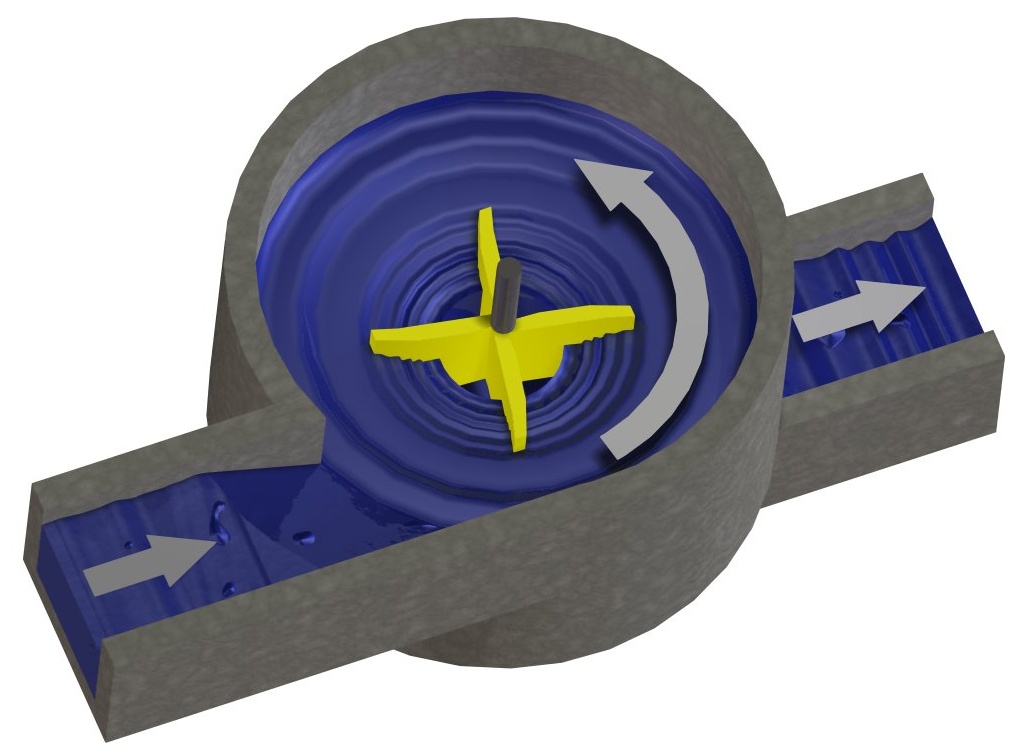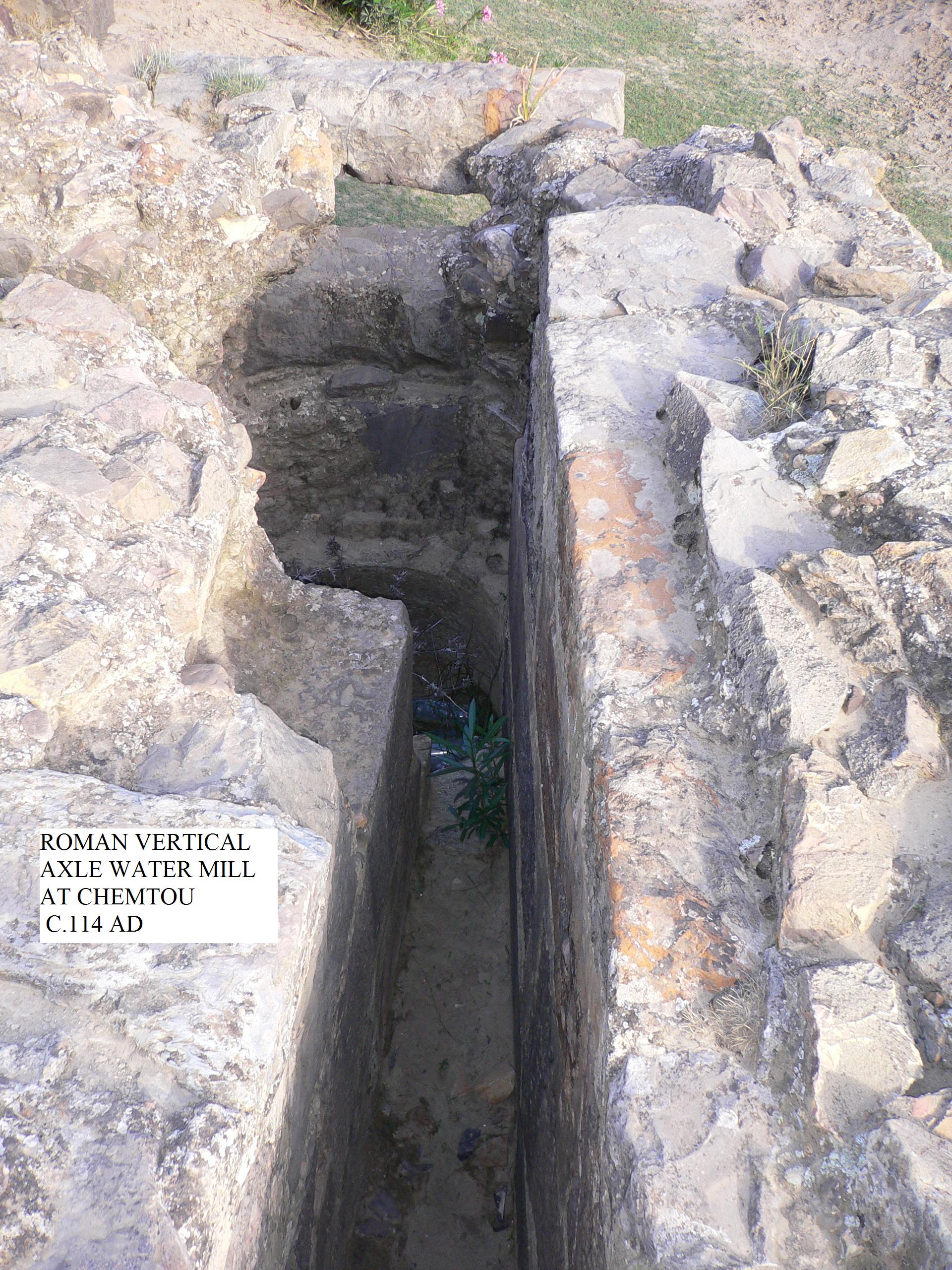|
Gravitation Water Vortex Power Plant
The gravitation water vortex power plant is a type of micro hydro vortex turbine system which converts energy in a moving fluid to rotational energy using a low hydraulic head of . This technology is based on a round basin with a central drain. Above the drain, the water forms a stable Free vortex, line vortex which drives a water turbine. Precourse designs were patented in 1877 and 1967. The specific design described here was first patented by Greek-Australian lawyer and inventor Paul Kouris in 1996, who was searching for a way to harness the power inherent in a vortex. Later, Austrian Inventor Franz Zotlöterer created a similar turbine while attempting to find a way to aeration, aerate water without an external power source. Design The water passes through a straight inlet and then passes tangentially into a round basin. The water forms a vortex over the center bottom drain of the basin. A turbine withdraws rotational energy from the vortex, which is converted into Electr ... [...More Info...] [...Related Items...] OR: [Wikipedia] [Google] [Baidu] |
Micro Hydro
Micro hydro is a type of hydroelectric power that typically produces from 5 kW to 100 kW of electricity using the natural flow of water. Installations below 5 kW are called pico hydro. These installations can provide power to an isolated home or small community, or are sometimes connected to electric power networks, particularly where net metering is offered. There are many of these installations around the world, particularly in developing nations as they can provide an economical source of energy without the purchase of fuel. Micro hydro systems complement solar PV power systems because in many areas water flow, and thus available hydro power, is highest in the winter when solar energy is at a minimum. Micro hydro is frequently accomplished with a pelton wheel for high head, low flow water supply. The installation is often just a small dammed pool, at the top of a waterfall, with several hundred feet of pipe leading to a small generator housing. In low head site ... [...More Info...] [...Related Items...] OR: [Wikipedia] [Google] [Baidu] |
Rotational Energy
Rotational energy or angular kinetic energy is kinetic energy due to the rotation of an object and is part of its total kinetic energy. Looking at rotational energy separately around an object's axis of rotation, the following dependence on the object's moment of inertia is observed: E_\text = \tfrac I \omega^2 where The mechanical work required for or applied during rotation is the torque times the rotation angle. The instantaneous power of an angularly accelerating body is the torque times the angular velocity. For free-floating (unattached) objects, the axis of rotation is commonly around its center of mass. Note the close relationship between the result for rotational energy and the energy held by linear (or translational) motion: E_\text = \tfrac m v^2 In the rotating system, the moment of inertia, ''I'', takes the role of the mass, ''m'', and the angular velocity, \omega , takes the role of the linear velocity, ''v''. The rotational energy of a rolling cylinder varie ... [...More Info...] [...Related Items...] OR: [Wikipedia] [Google] [Baidu] |
Hydraulic Head
Hydraulic head or piezometric head is a measurement related to liquid pressure (normalized by specific weight) and the liquid elevation above a vertical datum., 410 pages. See pp. 43–44., 650 pages. See p. 22, eq.3.2a. It is usually measured as an equivalent liquid surface elevation, expressed in units of length, at the entrance (or bottom) of a piezometer. In an aquifer, it can be calculated from the depth to water in a piezometric well (a specialized water well), and given information of the piezometer's elevation and screen depth. Hydraulic head can similarly be measured in a column of water using a standpipe piezometer by measuring the height of the water surface in the tube relative to a common datum. The hydraulic head can be used to determine a ''hydraulic gradient'' between two or more points. Definition In fluid dynamics, the ''head'' at some point in an incompressible (constant density) flow is equal to the height of a static column of fluid whose pressure at ... [...More Info...] [...Related Items...] OR: [Wikipedia] [Google] [Baidu] |
Free Vortex
In fluid dynamics, a vortex (: vortices or vortexes) is a region in a fluid in which the flow revolves around an axis line, which may be straight or curved. Vortices form in stirred fluids, and may be observed in smoke rings, whirlpools in the wake of a boat, and the winds surrounding a tropical cyclone, tornado or dust devil. Vortices are a major component of turbulent flow. The distribution of velocity, vorticity (the curl of the flow velocity), as well as the concept of circulation are used to characterise vortices. In most vortices, the fluid flow velocity is greatest next to its axis and decreases in inverse proportion to the distance from the axis. In the absence of external forces, viscous friction within the fluid tends to organise the flow into a collection of irrotational vortices, possibly superimposed to larger-scale flows, including larger-scale vortices. Once formed, vortices can move, stretch, twist, and interact in complex ways. A moving vortex carries so ... [...More Info...] [...Related Items...] OR: [Wikipedia] [Google] [Baidu] |
Water Turbine
A water turbine is a rotary machine that converts kinetic energy and potential energy of water into mechanical work. Water turbines were developed in the 19th century and were widely used for industrial power prior to electrical grids. Now, they are mostly used for electric power generation. Water turbines are mostly found in dams to generate electric power from water potential energy. History Water wheels have been used for hundreds of years for industrial power. Their main shortcoming is size, which limits the flow rate and head (hydraulic), head that can be harnessed. The migration from water wheels to modern turbines took about one hundred years. Development occurred during the Industrial Revolution, using scientific principles and methods. They also made extensive use of new materials and manufacturing methods developed at the time. Swirl The word turbine was introduced by the French engineer Claude Burdin in the early 19th century and is derived from the Greek w ... [...More Info...] [...Related Items...] OR: [Wikipedia] [Google] [Baidu] |
Aeration
Aeration (also called aerification or aeriation) is the process by which air is circulated through, mixed with or dissolved in a liquid or other substances that act as a fluid (such as soil). Aeration processes create additional surface area in the mixture, allowing greater chemical or suspension reactions. Aeration of liquids Methods Aeration of liquids (usually water) is achieved by: * passing air through the liquid by means of the Venturi tube, aeration turbines or compressed air which can be combined with diffuser(s) air stone(s), as well as fine bubble diffusers, coarse bubble diffusers or linear aeration tubing. Ceramics are suitable for this purpose, often involving dispersion of fine air or gas bubbles through the porous ceramic into a liquid. The smaller the bubbles, the more gas is exposed to the liquid increasing the gas transfer efficiency. Diffusers or spargers can also be designed into the system to cause turbulence or mixing if desired. Porous ceramic diffusers ... [...More Info...] [...Related Items...] OR: [Wikipedia] [Google] [Baidu] |
Electrical Energy
Electrical energy is the energy transferred as electric charges move between points with different electric potential, that is, as they move across a voltage, potential difference. As electric potential is lost or gained, work is done changing the energy of some system. The amount of work in Joule, joules is given by the product of the charge that has moved, in Coulomb, coulombs, and the potential difference that has been crossed, in Volt, volts. Electrical energy is usually sold by the kilowatt hour (1 kW·h = 3.6 MJ) which is the product of the power in kilowatts multiplied by running time in hours. Electric utilities measure energy using an electricity meter, which keeps a running total of the electrical energy delivered to a customer. Electric heating is an example of converting electrical energy into thermal energy. The simplest and most common type of electric heater uses electrical resistance to convert the energy. There are other ways to use electrical energy. Electri ... [...More Info...] [...Related Items...] OR: [Wikipedia] [Google] [Baidu] |
Energy Conversion Efficiency
Energy conversion efficiency (''η'') is the ratio between the useful output of an energy conversion machine and the input, in energy terms. The input, as well as the useful output may be chemical, electric power, mechanical work, light (radiation), or heat. The resulting value, ''η'' (eta), ranges between 0 and 1. Overview Energy conversion efficiency depends on the usefulness of the output. All or part of the heat produced from burning a fuel may become rejected waste heat if, for example, work is the desired output from a thermodynamic cycle. Energy converter is an example of an energy transformation. For example, a light bulb falls into the categories energy converter. \eta = \frac Even though the definition includes the notion of usefulness, efficiency is considered a technical or physical term. Goal or mission oriented terms include effectiveness and efficacy. Generally, energy conversion efficiency is a dimensionless number between 0 and 1.0, or 0% to 100%. ... [...More Info...] [...Related Items...] OR: [Wikipedia] [Google] [Baidu] |
US Dollar
The United States dollar (symbol: $; currency code: USD) is the official currency of the United States and several other countries. The Coinage Act of 1792 introduced the U.S. dollar at par with the Spanish silver dollar, divided it into 100 cents, and authorized the minting of coins denominated in dollars and cents. U.S. banknotes are issued in the form of Federal Reserve Notes, popularly called greenbacks due to their predominantly green color. The U.S. dollar was originally defined under a bimetallic standard of (0.7734375 troy ounces) fine silver or, from 1834, fine gold, or $20.67 per troy ounce. The Gold Standard Act of 1900 linked the dollar solely to gold. From 1934, its equivalence to gold was revised to $35 per troy ounce. In 1971 all links to gold were repealed. The U.S. dollar became an important international reserve currency after the First World War, and displaced the pound sterling as the world's primary reserve currency by the Bretton Woods Ag ... [...More Info...] [...Related Items...] OR: [Wikipedia] [Google] [Baidu] |
Watt
The watt (symbol: W) is the unit of Power (physics), power or radiant flux in the International System of Units (SI), equal to 1 joule per second or 1 kg⋅m2⋅s−3. It is used to quantification (science), quantify the rate of Work (physics), energy transfer. The watt is named in honor of James Watt (1736–1819), an 18th-century Scottish people, Scottish inventor, mechanical engineer, and chemist who improved the Newcomen engine with his own Watt steam engine, steam engine in 1776, which became fundamental for the Industrial Revolution. Overview When an object's velocity is held constant at one meter per second against a constant opposing force of one Newton (unit), newton, the rate at which Work (physics), work is done is one watt. \mathrm. In terms of electromagnetism, one watt is the rate at which electrical work is performed when a current of one ampere (A) flows across an electrical potential difference of one volt (V), meaning the watt is equivalent to the vo ... [...More Info...] [...Related Items...] OR: [Wikipedia] [Google] [Baidu] |





